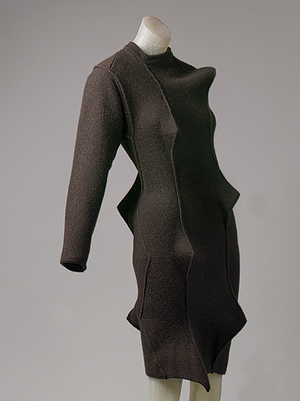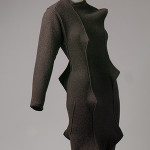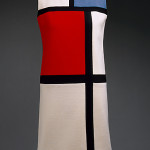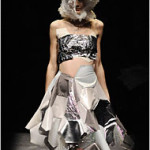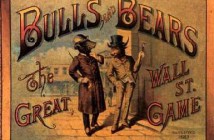ART AS FASHION, PART ONE
Fashion and art have frequently run on parallel tracks historically (and sometimes hysterically.) Art has been used to cloak in grandeur what is otherwise a commercial enterprise and money made in the rag trade has probably supported more artists than funding from popes and monarchs. Art elevates fashion and fashion pays for art. And like a Cornelia Parker installation, they both pull a lot of fractured old silver on a fish line behind them.
Sit back, ‘cause here comes a little history. By the 1920s fashion was France’s second largest export and it established benchmarks for quality and style. Ralph Lauren, a smart but poor boy from the Bronx, ne: Lifshitz, was not the first fashion pro to parlay a reproduction of the aristocratic tradition, one that allowed people to feel that by dressing a certain way they now belonged to an elite, into a mega-humongous-dollar empire. The premise early on was that if you scored a front row seat at the Paris fashion shows, if you bought your clothes from say Coco Chanel, herself an abandoned orphan who financed her business on her back, it meant that you could trace your lineage to a Victoria, an Elizabeth or one of several Georges or Edwards with roman numerals after their name. The coin of the realm was a link to a throne somewhere, substantiated by a lot of oil portraits hanging around the dining room.
Fast forward to the 21st century where being a celebrity has replaced the claims to royal roots and where the front rows at sexed up fashion shows were occupied by women who carry intravenous devices in their large “It” bags that continuously pump narcissism into their veins. Being seen at the most current art openings, often sponsored by fashion or cosmetics concerns, was almost as vital as those front row seats and the red carpet photo opps. Fortunately just as exhibition fatigue was about to set in the recession pulled the plug on art as commodity and fashion as three-ring porn circus.
Is it time to break into a sprint of joy? Is the reality check on many levels going to spawn some quality icons of our time? Is being on the verge of collapse an opportunity to dismantle the “I-must-impress-fast” machinery? Yes, yes and yes. If “austerity is the new chic” then it is also OK to chuck words like “overrated” and “underwhelming,” and admit that being joyless is eating our brain.
Art and fashion are both forms of communication and hum along best when they’re forced to be honest. It takes courage and emotional elbow grease to produce simplicity. Time now to discard fashion’s uncertain beginnings and call it what it is: an expression of ourselves that we want to put out there that will cuddle our self-esteem. Is Marc Jacobs an artist? Are Jason Wu, Michael Kors, Patrick Robinson, the Proenza-Schuler boys, Diane Von Furstenberg, Nanette Lepore, Alexander Wang? Probably not. They’re nice, bright people trying to stay alive and make a living. Yet there are others who are indeed artists and, according to Cathy Horyn, fashion editor of the New York Times, “make us see something unique and maybe profound about the contemporary world.” It is what we expect of artists working today, is it not?
At the New York Times Online’s feature where readers can write in to Cathy Horyn, one of the questions recently posed was,
“Is fashion relevant as an art form?” and Horyn’s response was to single out a handful of designers who may fit the bill. She zeroed in on Rei Kawakubo of Comme Des Garcons who gives deliberately vague instructions to her patternmakers and then refines their efforts to express her own views before sending the garments down the runway.
The editors and those-in-the-know who populate the fashion shows have come to expect that Kawakubo’s work is not easy to wear or decipher yet they’re unable to look away because she, along with Mariuccia Prada, Alexander McQueen, Martin Margiela, Hussein Chalayan, Issey Miyake and Yohji Yamamoto are considered intellectual designers. Artists in their own right unlike other fashion people who are often merely influenced by art and who spin their collections accordingly. Occasionally it is because of an art form that designers are put on the map, a good example being Giorgio Armani who came into the limelight thanks to the film, “An American Gigolo.” Or the trajectory of the recently deceased Yves St. Laurent who was a master at bringing street wear unto the hallowed French runway, plugging into the zeitgeist and interpreting it for the mass media who would disseminate it to the “ladies who lunch.” Art at work.
We must debunk the facts that real art involves a sudden act of ear cutting or that real fashion is born of either the love or the hatred of women. We need to see the marriage of art and fashion not as merely one of convenience but as the parallel labors of visionary individuals who are highly tuned in, opinionated and intellectually gifted.
- Issey Miyake, Dress, brown Wool knit, 1989.
- Yves Saint Laurent, “Mondrian” day dress, Wool jersey in color blocks of white, red, blue, black, and yellow, 1965.
- Rei Kawakubo, The Comme des Garcons runway show, Fall 2009.

